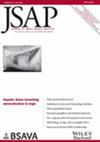Prevalence of behavioural signs commonly associated with feline hyperaesthesia syndrome among healthy cats
Abstract
Objectives
The most common clinical signs of feline hyperaesthesia syndrome are rolling skin and behavioural abnormalities (e.g. licking or biting the tail, flanks, anal region or lumbar region). This study aimed to determine the prevalence of behavioural signs commonly associated with feline hyperaesthesia syndrome among healthy cats.
Materials and Methods
This descriptive cross-sectional bicentric prospective study included 208 healthy cats that presented for vaccination. A survey about the cats' behaviour was completed by caregivers and six general practice veterinarians.
Results
Seventy-three per cent of the cats presented at least one behavioural sign of feline hyperaesthesia syndrome. Only 26.9% of the caregivers report zero behavioural of feline hyperaesthesia syndrome at home. Eighty per cent of the indoor-only cats and 65.3% of the outdoor cats had at least one behavioural sign (odds ratio 2.08, 95% confidence interval 1.12 to 3.88). Thirty-one per cent of the cats reacted to lumbar palpation by veterinarians, and 18.7% of these cats were not reported to present signs of feline hyperaesthesia syndrome at home.
Clinical Significance
In this population of healthy cats, 73.1% of cats consistently displayed at least one behavioural sign of feline hyperaesthesia syndrome at home. Adverse reactions after lumbar palpation by a veterinarian were also reported in healthy cats, including cats without behavioural signs at home. The results suggest that many of these behavioural signs have no diagnostic value in isolation. A scoring system could be used to differentiate cats with feline hyperaesthesia syndrome from cats with normal behaviour.


 求助内容:
求助内容: 应助结果提醒方式:
应助结果提醒方式:


